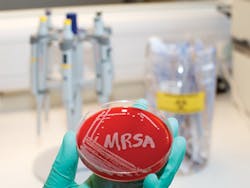GENOMICS/DISEASE CONTROL: First-ever stoppage of MRSA outbreak by gene sequencing technology
"Our study highlights the power of advanced DNA sequencing used in real time to directly influence infection control procedures," said Prof. Julian Parkhill of the Wellcome Trust Sanger Institute (Hinxton, England). "This technology... could lead to a paradigm shift in how we manage infection control and practice."
Parkhill is co-author of a paper describing the first-ever use of whole genome sequencing to help control an infectious disease outbreak in a hospital.1 Researchers from Wellcome Trust Sanger, the University of Cambridge, and Cambridge University Hospitals, all in England, used the technology to confirm an ongoing outbreak of methicillin-resistant Staphylococcus aureus (MRSA) in a Special Care Baby Unit in real time. This allowed earlier stoppage of the outbreak, saving possible harm to patients.
Using this technology, the team found that the outbreak had extended into the wider community, a conclusion that could not be reached with available methods. They also used sequencing to link the outbreak to an unsuspecting carrier, who was treated to eradicate MRSA. They report that DNA sequencing is far more accurate than current methods used to detect hospital outbreaks.
The study helped everyone involved glimpse a future in which sequencing will help identify, manage, and stop hospital outbreaks, according to Nick Brown, MD, another co-author as well as consultant microbiologist at the Health Protection Agency and infection control doctor at Addenbrooke's Hospital Cambridge. Over six months prior to the study, the hospital used standard protocols to identify 12 patients who were carrying MRSA—but personnel were not able to get enough information to confirm or deny whether an outbreak was taking place.
The team will now study all MRSA carriers and infected patients over the next year—in multiple hospitals, including Addenbrooke's, and the surrounding community—to further understand transmission events and improve infection management.
1. S. R. Harris et al., Lancet Infect. Dis., doi:10.1016/S1473-3099(12)70268-2 (2012).

